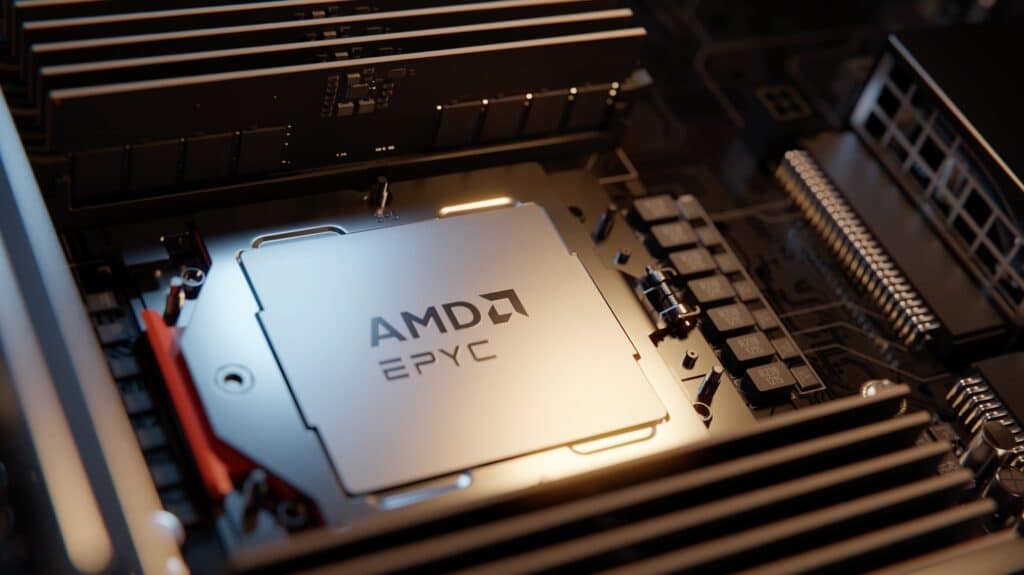Here’s the text translated into American English:
<div>
<p>Cloud computing continues to evolve rapidly, driven by the demand for higher performance, energy efficiency, and support for increasingly demanding workloads. In this context, <strong>Google Cloud and AMD</strong> have jointly introduced the new <strong>C4D and H4D instances</strong>, based on <strong><a href="https://revistacloud.com/amd-presenta-la-los-procesadores-integrados-amd-epyc-de-5a-generacion/" data-type="post" data-id="33014">5th Generation AMD EPYC processors</a></strong>, aimed at delivering leading performance for artificial intelligence (AI), data analytics, and high-performance computing (HPC) environments.</p>
<p>These new virtual machines (VMs) represent a <strong>generational leap</strong> in both capacity and efficiency. According to figures shared by Google, the C4D instances allow for up to <strong>80% more performance per vCPU</strong> compared to previous generations, while the H4D instances are optimized for large HPC clusters, achieving <strong>200 Gbps of RDMA network bandwidth</strong>.</p>
<h3 class="wp-block-heading">Direct competition with specialized AWS and Azure instances</h3>
<p>This move positions Google Cloud as a more aggressive player in the battle for the cloud infrastructure market, especially against AWS and Microsoft Azure. With an expected <strong>annual growth of over 15%</strong> for high-performance cloud services, the new instances target both digital native companies and large corporations migrating critical applications to the cloud environment.</p>
<p><strong>Raúl Aledo</strong>, CEO of Grupo Aire (a European cloud infrastructure specialist), emphasizes that “the advancement of optimized instances like C4D and H4D confirms that differentiation in the cloud market no longer depends solely on price, but also on the ability to customize and scale based on each business need.”</p>
<h3 class="wp-block-heading">C4D: General performance for enterprise environments</h3>
<p>Designed for general workloads and AI inference tasks, the C4D instances stand out with their high clock speed (up to 4.1 GHz) and flexible configurations ranging from 2 to 384 vCPUs with up to 3 TB of DDR5 memory. They are specifically designed for <strong>databases, web servers, caches, and microservices</strong>, with a 55% improvement in queries per second in MySQL and up to 80% more efficiency in web servers compared to C3D instances.</p>
<h3 class="wp-block-heading">H4D: High performance for science and engineering</h3>
<p>The new H4D instances offer over <strong>12,000 GFLOPS per node</strong>, over 950 GB/s memory bandwidth, and are designed to scale to tens of thousands of cores, ideal for scientific simulations, complex data analysis, and large-scale AI training. According to Altair, their Radioss software for impact simulations has experienced a <strong>360% performance improvement</strong> using H4D, opening up new possibilities in sectors such as automotive, aerospace, and biomedicine.</p>
<h3 class="wp-block-heading">Hybrid cloud and cost optimization</h3>
<p>This alliance also strengthens Google’s strategy to consolidate its <strong>hybrid and scalable infrastructure</strong> model, particularly with the introduction of <strong>bare-metal</strong> and optimized storage with <strong>Hyperdisk Exapools</strong>, aimed at large AI clusters with needs for <strong>exabytes of data and multiple terabytes per second of performance</strong>.</p>
<p>These innovations arrive at a pivotal moment: as major tech companies seek to optimize their infrastructure and costs, the new options allow customers to combine leading performance with reduced TCO, which could represent a significant competitive advantage.</p>
<h3 class="wp-block-heading">Availability</h3>
<p>The C4D and H4D instances have been made available in <strong>preview version</strong> starting this week and are expected to reach <strong>global regions</strong> in their general availability version before the end of 2025.</p>
</div>Feel free to reach out if you need any more assistance!

